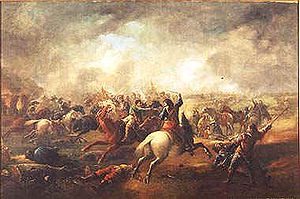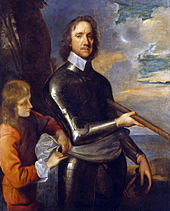Battle of Marston Moor
| date | July 2, 1644 |
|---|---|
| place | at Long Marston, 10 kilometers west of York , England |
| output | decisive parliamentary / Scottish victory |
| consequences | The north was finally lost to the king, York surrendered on July 16. Count Palatine Rupert had ruined his brilliant success in the relief of York by an unnecessary battle. If the siege had continued, the Allied troops would probably have broken off their action |
| Parties to the conflict | |
|---|---|
|
Scottish Covenanters , |
Royal Troops, Newcastle |
| Commander | |
|
Earl of Leven , Oliver Cromwell, |
Ruprecht von der Pfalz , |
| Troop strength | |
| 8,000 cavalrymen, 1,000 dragoons, 12,200 foot soldiers, 30–40 cannons |
6,000 horsemen, 11,000 foot soldiers, 14 cannons |
| losses | |
|
approx. 2000 allies |
around 3,000 royalists are estimated |
Wars of the Three Kingdoms (1639–1651) in Scotland
Newburn - Marston Moor - Tippermuir - Aberdeen (1644) - Inverlochy (1645) - Lagganmore - Auldearn - Carlisle (1645) - Alford - Kilsyth - Philiphaugh - Aberdeen (1646) - Rhunahaorine Moss - Dunaverty - Mauchline Muir - Preston (1648) - Whiggamore Raid - Stirling (1648) - Inverness (1649) - Inverness (1650) - Carbisdale - Dunbar (1650) - Inverkeithing - Worcester - Tullich
The Battle of Marston Moor ( English Battle of Marston Moor ) took place on July 2, 1644 not far from York and was one of the decisive battles of the English Civil War . In it the army of Parliament won its first major victory over the royalists , who thereby lost all of northern England.
prehistory
After the outbreak of the Civil War in 1642, King Charles I's troops initially managed to bring almost the entire north and west of England, including Wales, under their control. The intervention of the Scots in the civil war in 1643 strengthened the position of Parliament again. The royalists' position in northern England became precarious in the summer of 1644 when their last stronghold in the region, the city of York, was besieged by troops of Parliament and the Scots under Alexander Leslie, 1st Earl of Leven .
The general of the royal army, Prince Ruprecht von der Pfalz , decided to terrorize York and marched north. The commanders of the parliamentary army were warned of the imminent threat by their cavalry, lifted the siege and advanced to meet the royalists. Prince Ruprecht avoided them at first and took York.
course
On July 2, Ruprecht encountered small cavalry units of the parliamentary army, 11 km west of the city, near Long Marston , including the recently recruited so-called Ironsides by Oliver Cromwell . Both sides sent for support. On the royalist side, the troops of the Commander of York, the Marquess of Newcastle , intervened in the battle, on the side of Parliament the units of Lord Thomas Fairfax , the Earl of Leven and the Earl of Manchester .
Parliament's armed forces - some 23,000 in all - were in the south, with the foot troops under Leven, Fairfax and Manchester in the center. The cavalry under Cromwell, David Leslie and Fairfax's son Thomas covered the flanks. Even with the royal troops, which sent around 14,000 soldiers into the field, the infantry under Newcastle stood in the middle and the cavalry troops under Goring and Byron on the sides. Prince Ruprecht commanded the withdrawn cavalry reserve. Since the day was well advanced, the royalists expected that the attack would not take place until the next day.
However, around 6 p.m. Leven ordered the attack by the Scots and the parliamentary army. This took some of the royal troops by surprise, who were getting ready to bivouack . Cromwell's Ironsides, assisted by David Leslies Reiter, drove Byron's cavalry back and then successfully turned against Prince Ruprecht's reserve.
On the other flank, Goring's cavalry threatened to gain the upper hand over the cavalry of Parliament under the younger Fairfax. They were already attacking the Scots in the center of the parliamentary army, so the commander-in-chief of the parliamentary troops, Leven, turned to flee and gave up the battle. But then all of a sudden Cromwell's elite force appeared and turned the tide.
The “godly party”, as Cromwell called his cavalry made up of staunch Puritans , first drove out Goring's cavalry and then took action against the royalist center together with Manchester's foot troops. After a short time the troops of Newcastle and Prince Ruprecht were either dead or on the run. In a report to Parliament after the battle, Cromwell wrote:
“We chased the entire prince's cavalry off the battlefield. God made them stubble under our swords in the cornfield. Then we took their regiments on foot with our cavalry and rode to shame everything that came in our way. "
The persecution of the royalists ended at nightfall. A total of about 4,000 men were killed at Marston Moor. This made the battle one of the bloodiest of the entire civil war.
consequences
After the main royalist power in the north of England was destroyed, Parliament gained control of the entire region. York surrendered on July 16, 1644. Prince Ruprecht lost the nimbus of invincibility due to the defeat, while Oliver Cromwell established his reputation as an able equestrian leader. Since he was both a military man and a member of parliament, he rose to become one of the key figures of the Civil War in the wake of the Battle of Marston Moor.
literature
- Antonia Fraser : Cromwell. Our Chief Of Men . Weidenfeld & Nicolson, London 1997, ISBN 0-297-81815-5 .
- Peter de Mendelssohn : Conscience and Power . In: Peter de Mendelssohn: The birth of parliament. Essays . Fischer, Frankfurt am Main 1983, ISBN 3-596-22524-8 , pp. 97-176.
- AA Evans, David Gibbson: Military History from Antiquity to Today
Web links
Coordinates: 53 ° 57 ′ 49 " N , 1 ° 15 ′ 43" W.

